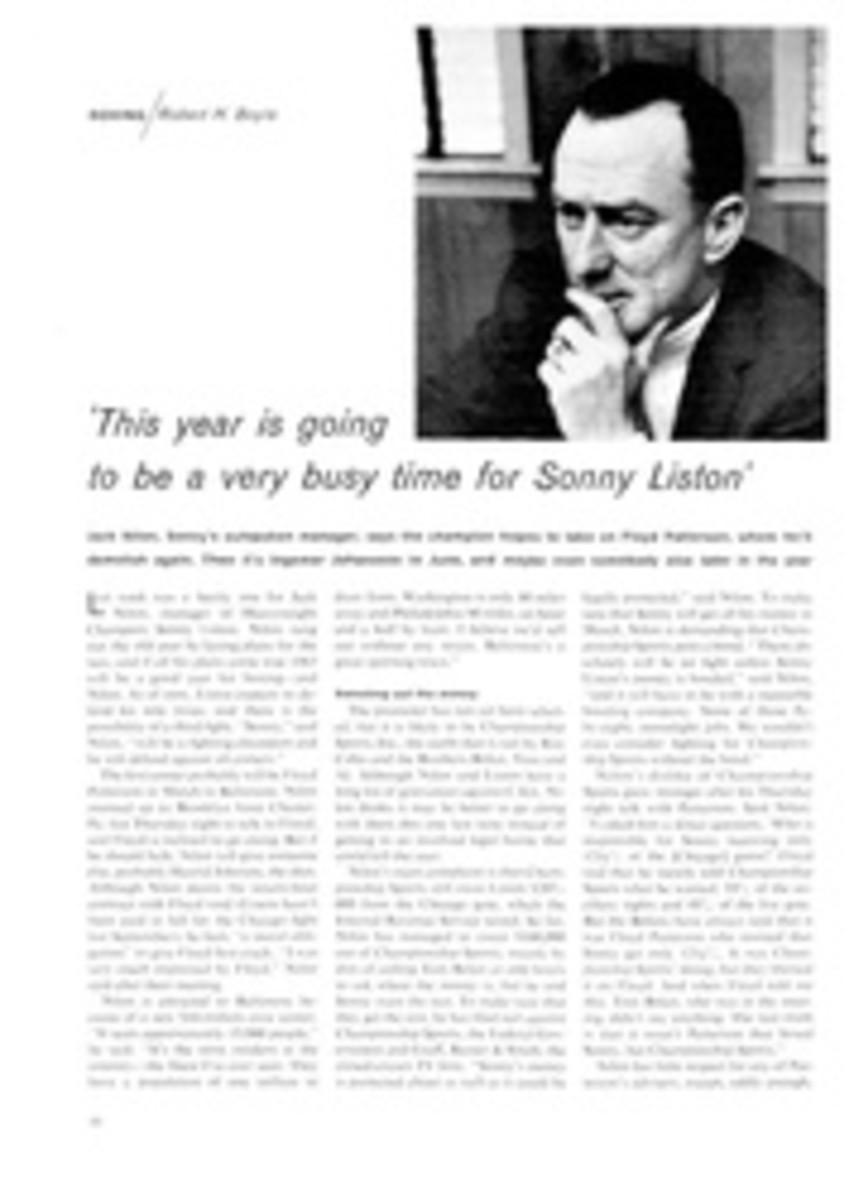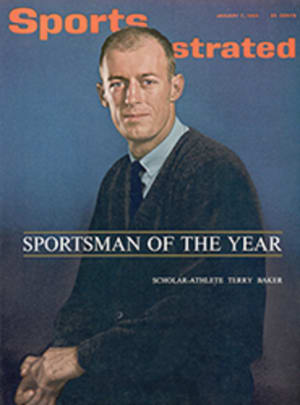
THE ABCs OF SQUASH RACQUETS
Squash racquets, commonly called squash, is difficult to master but easy to learn, and it offers rare opportunity for exercise and enjoyment to all players right down to the duffer level. On these pages, the University of Pennsylvania's Al Molloy, one of the nation's top teaching pros, offers beginners a primer on how to play—or watch—squash
A SPORT FOR EVERYONE
Shown below is the official design of a squash racquets court. Basically it is nothing more than a room with lines added and the top part of the back wall removed so spectators can see in. There are upward of 1,500 courts in the U.S. where businessmen play during lunch hour, suburban mothers when the housework is done, and youngsters whenever their elders leave the courts free. Part of the game's appeal is that the beginner can have as much fun swatting the ball as the expert.
The main rules are simple. To be good, a shot must hit the front wall between the telltale (a strip of tin at the bottom of the front wall) and the top of the wall. It may hit the side walls or the back wall before reaching the front wall. The ball must be struck before it has bounced twice, but it may be struck before bouncing. Either the server or receiver may score. The winner of the point becomes the server. Except in deuce situations, a game ends at 15 points. Because of its close quarters, squash, more than any other game, breeds courtesy to one's opponent for the excellent reason that getting in his way may prove dangerous.
GETTING SET TO HIT
In squash the ball rebounds off the wall so fast that a player must be far more alert and ready to go after a return than a tennis player. Ideally, after making his own shot he should take the center of the court, placing his heels about an inch in front of the floor service line, his body facing the front wall. He should be poised on the balls of his feet. Heels are about shoulder-width apart and weight is evenly distributed on both feet. Both elbows are kept in. His racket wrist should be cocked, and he should be in a crouching position. If his opponent is about to make a return from behind, the player should not face him but should keep his back to him, turning his head and upper body slightly toward whichever side the opponent is favoring, and watching him only out of the corner of his eye. His racket head should be raised somewhat by the left hand for protection. The rules of the game and good sense both insist that the player should give his opponent all the room he needs to swing a racket in.
GRASPING THE RACKET
The grip used by most players is the Continental grip shown above. This grip allows shots to be taken on the forehand, backhand and volley without changing finger or thumb position. To assume it, a player holds the racket throat in his left hand, racket face perpendicular to the floor, and places his right hand on the handle as though about to pick up a hammer. The heel of the hand should be a little to the right of the center of the handle, with fingers spread slightly—the index finger most of all. In the final position pressure should be felt not on the palm but on three points: the inner part of the thumb, the inside of the forefinger and the heel of the hand.
HITTING THE FOREHAND
Because the swing it requires is similar to the swing of an infielder's arm when he throws a baseball from the side, the forehand is the easiest stroke to learn in squash. The beginner should practice from a closed stance—that means left side to front wall, and left foot beyond the right foot. This position insures that the racket will be drawn back in time and that the body will have pivoted sufficiently to impart power to the shot. From the ready position the player takes a step to the right with his right foot, turning his hips and shoulders to the right so that they are parallel to the right wall. As he does so, he brings his racket back, keeping his forearm parallel to the floor. His right wrist is cocked. When the racket is straight up and down, with the racket head about even with the right ear, (here is a momentary pause. Then the left foot moves over to the right, weight is transferred to the left leg and the right forearm moves back until it is nearly parallel to the side walls. The racket, led by the cocked wrist, now starts forward (shown above) as the hips and shoulders pivot left. Its head moves in a path parallel to the floor until it reaches a point nearly opposite the left knee. Here the wrist whips the racket through the ball in a snapping action controlled mainly by the index finger and the thumb. After hitting the ball, the player lets his arm flow into an easy follow-through and finishes the stroke in a crouched position to be ready for the next shot.
UNCOILING THE BACKHAND
For squash players the backhand is seldom the bugaboo it is for beginning tennis players. One reason is that the squash backhand can be hit with all the power that the striker can provide and the ball will still not go out of court. As with the forehand, the closed stance is the recommended position. To hit the backhand, the player moves his left foot a step to the left, turning his shoulders and hips in the same direction. His weight is mainly on the left foot. His right wrist is cocked to the left and upward as he holds the racket shaft at about a 45° angle to the floor, racket head at about eye level. He pauses briefly, moves his right foot a step to the left, putting his weight on the right leg. His hips and shoulders are drawn farther around, his right shoulder is lowered and the racket is drawn farther back. As the powerful uncoiling process begins (shown left), hips and shoulders move forward and the cocked wrist takes the racket forward. At a point about six inches in front of the right foot the ball is struck, the wrist whipping through for extra speed. In this stroke, pressure is felt mainly on the thumb. The follow-through, as with the forehand, should find the player in a crouched position.
LOB AND SLICE SERVES
The most popular serve Is the lob—partly because its nearly vertical trajectory makes it difficult to return when it falls close to the side wall and partly because it can be hit with little effort. To deliver it, the player drops the ball with the left hand and the racket is brought up to meet it in an underhand motion (see drawing page 40). The point of aim is high up on the front wall, close to the center.
The slice serve (right) is most effective on courts with low ceilings and, on any court, as a change of pace. The ball is tossed up and to the right, while the racket is taken back to the right side, the racket head being raised to about shoulder height. As the ball is struck, the strings are drawn sharply across it, from right to left, imparting a vigorous spin. Aim point is just above the service line.
THE HARD SERVE
Of the three basic squash serves—lob, slice and hard—the last most nearly approximates the serve in tennis. Serving to a receiver in the right court, the player puts his right foot in the left quarter circle, his left foot outside the quarter circle and in front of the floor service line. Facing the front wall, he tosses the ball up so that it can be hit at a point above his right shoulder. At the top of the ball's trajectory, he brings the racket forward in a throwing motion. The ball should be hit flat and aimed low—as close to the front-wall service line as possible. Breaking the wrist as the ball is hit adds power. To serve to the left court, the server places his right foot inside the right quarter circle and proceeds as before. The hard serve is useful against an opponent perplexed by its speed or against a tired opponent.
To receive a serve, a player in the left court faces the side wall nearer him, heels about three inches inside the center service line, watching the server and expecting to take the serve on his backhand. In the right court, the position is similar, but the player receiving in this court will expect to take the served ball on his forehand.
BACKING ON A BACKHAND
Squash is a game of guile as well as speed, anticipation and endurance. The position of each player is constantly dependent on the position of the other. Because of the fast pace of the game, there sometimes seems to be little room for either. As shown in the sample situation above, this can often be turned to tactical advantage. The player in the white shirt has hit a bad shot that has come far off the back wall. The dark-shirted player, aware that his opponent must give him room to swing for a hard down-court shot, delays his stroke to block his opponent and force him out of position in center court, setting up an easy placement.
EIGHT ILLUSTRATIONS
FRANK MULLINS
DIAGRAM
DON MOSS
SERVICE LINE
TELL
TALE
SERVICE LINE
SERVING QUARTER CIRCLE
SERVICE QUARTER CIRCLE
CENTER SERVICE
LINE
BACK
WALL
16 feet
18½ feet
32 feet

